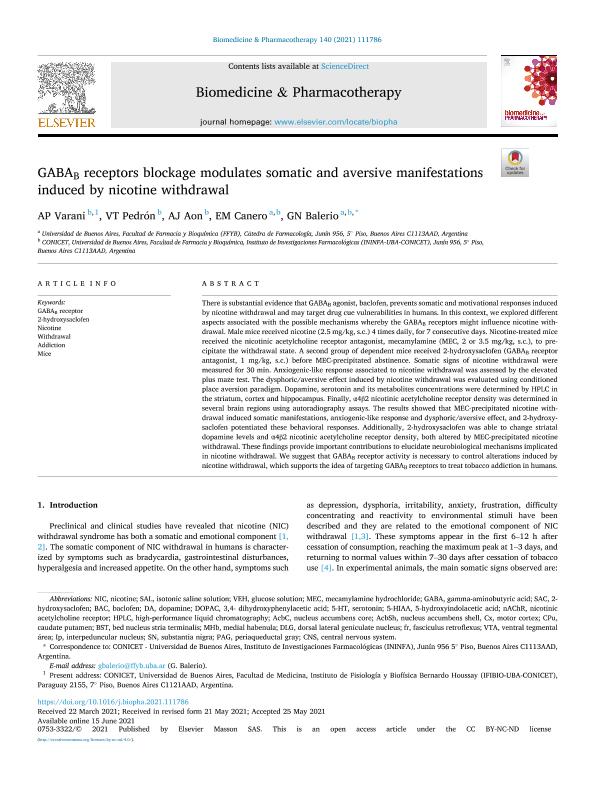Artículo
GABAB receptors blockage modulates somatic and aversive manifestations induced by nicotine withdrawal
Varani, Andrés Pablo ; Pedrón, Valeria Teresa
; Pedrón, Valeria Teresa ; Gaona Currea, José Alberto; Canero, Eliana Micaela; Balerio, Graciela Noemí
; Gaona Currea, José Alberto; Canero, Eliana Micaela; Balerio, Graciela Noemí
 ; Pedrón, Valeria Teresa
; Pedrón, Valeria Teresa ; Gaona Currea, José Alberto; Canero, Eliana Micaela; Balerio, Graciela Noemí
; Gaona Currea, José Alberto; Canero, Eliana Micaela; Balerio, Graciela Noemí
Fecha de publicación:
08/2021
Editorial:
Elsevier France-Editions Scientifiques Medicales Elsevier
Revista:
Biomedicine & Pharmacotherapy = Biomedecine & Pharmacotherapie
ISSN:
0753-3322
Idioma:
Inglés
Tipo de recurso:
Artículo publicado
Clasificación temática:
Resumen
There is substantial evidence that GABAB agonist, baclofen, prevents somatic and motivational responses induced by nicotine withdrawal and may target drug cue vulnerabilities in humans. In this context, we explored different aspects associated with the possible mechanisms whereby the GABAB receptors might influence nicotine withdrawal. Male mice received nicotine (2.5 mg/kg, s.c.) 4 times daily, for 7 consecutive days. Nicotine-treated mice received the nicotinic acetylcholine receptor antagonist, mecamylamine (MEC, 2 or 3.5 mg/kg, s.c.), to precipitate the withdrawal state. A second group of dependent mice received 2-hydroxysaclofen (GABAB receptor antagonist, 1 mg/kg, s.c.) before MEC-precipitated abstinence. Somatic signs of nicotine withdrawal were measured for 30 min. Anxiogenic-like response associated to nicotine withdrawal was assessed by the elevated plus maze test. The dysphoric/aversive effect induced by nicotine withdrawal was evaluated using conditioned place aversion paradigm. Dopamine, serotonin and its metabolites concentrations were determined by HPLC in the striatum, cortex and hippocampus. Finally, α4β2 nicotinic acetylcholine receptor density was determined in several brain regions using autoradiography assays. The results showed that MEC-precipitated nicotine withdrawal induced somatic manifestations, anxiogenic-like response and dysphoric/aversive effect, and 2-hydroxysaclofen potentiated these behavioral responses. Additionally, 2-hydroxysaclofen was able to change striatal dopamine levels and α4β2 nicotinic acetylcholine receptor density, both altered by MEC-precipitated nicotine withdrawal. These findings provide important contributions to elucidate neurobiological mechanisms implicated in nicotine withdrawal. We suggest that GABAB receptor activity is necessary to control alterations induced by nicotine withdrawal, which supports the idea of targeting GABAB receptors to treat tobacco addiction in humans.
Palabras clave:
2-HYDROXYSACLOFEN
,
ADDICTION
,
GABAB RECEPTOR
,
MICE
,
NICOTINE
,
WITHDRAWAL
Archivos asociados
Licencia
Identificadores
Colecciones
Articulos(IFIBIO HOUSSAY)
Articulos de INSTITUTO DE FISIOLOGIA Y BIOFISICA BERNARDO HOUSSAY
Articulos de INSTITUTO DE FISIOLOGIA Y BIOFISICA BERNARDO HOUSSAY
Articulos(ININFA)
Articulos de INST.DE INVEST.FARMACOLOGICAS (I)
Articulos de INST.DE INVEST.FARMACOLOGICAS (I)
Citación
Varani, Andrés Pablo; Pedrón, Valeria Teresa; Gaona Currea, José Alberto; Canero, Eliana Micaela; Balerio, Graciela Noemí; GABAB receptors blockage modulates somatic and aversive manifestations induced by nicotine withdrawal; Elsevier France-Editions Scientifiques Medicales Elsevier; Biomedicine & Pharmacotherapy = Biomedecine & Pharmacotherapie; 140; 8-2021; 1-15
Compartir
Altmétricas



